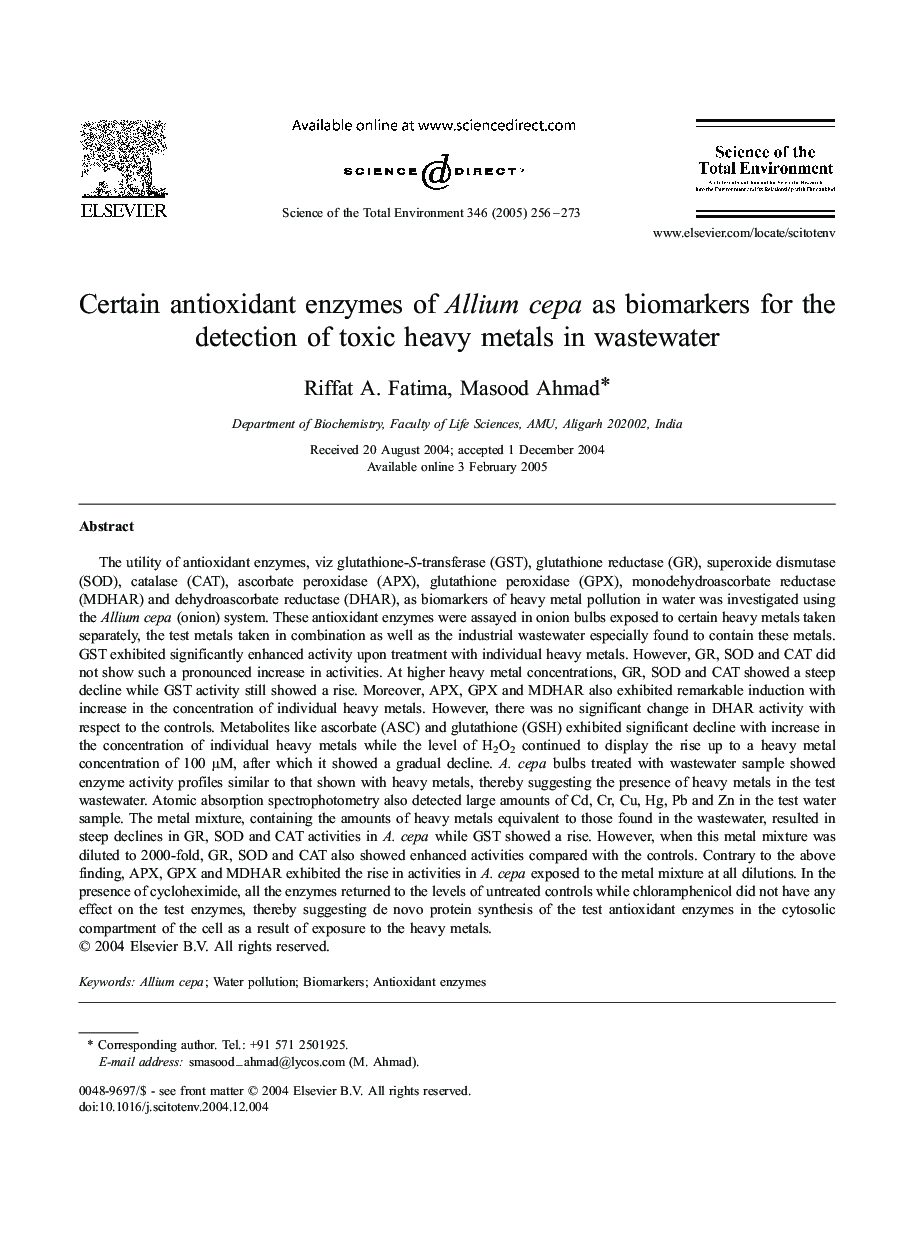| کد مقاله | کد نشریه | سال انتشار | مقاله انگلیسی | نسخه تمام متن |
|---|---|---|---|---|
| 10110746 | 1619992 | 2005 | 18 صفحه PDF | دانلود رایگان |
عنوان انگلیسی مقاله ISI
Certain antioxidant enzymes of Allium cepa as biomarkers for the detection of toxic heavy metals in wastewater
دانلود مقاله + سفارش ترجمه
دانلود مقاله ISI انگلیسی
رایگان برای ایرانیان
کلمات کلیدی
موضوعات مرتبط
علوم زیستی و بیوفناوری
علوم محیط زیست
شیمی زیست محیطی
پیش نمایش صفحه اول مقاله

چکیده انگلیسی
The utility of antioxidant enzymes, viz glutathione-S-transferase (GST), glutathione reductase (GR), superoxide dismutase (SOD), catalase (CAT), ascorbate peroxidase (APX), glutathione peroxidase (GPX), monodehydroascorbate reductase (MDHAR) and dehydroascorbate reductase (DHAR), as biomarkers of heavy metal pollution in water was investigated using the Allium cepa (onion) system. These antioxidant enzymes were assayed in onion bulbs exposed to certain heavy metals taken separately, the test metals taken in combination as well as the industrial wastewater especially found to contain these metals. GST exhibited significantly enhanced activity upon treatment with individual heavy metals. However, GR, SOD and CAT did not show such a pronounced increase in activities. At higher heavy metal concentrations, GR, SOD and CAT showed a steep decline while GST activity still showed a rise. Moreover, APX, GPX and MDHAR also exhibited remarkable induction with increase in the concentration of individual heavy metals. However, there was no significant change in DHAR activity with respect to the controls. Metabolites like ascorbate (ASC) and glutathione (GSH) exhibited significant decline with increase in the concentration of individual heavy metals while the level of H2O2 continued to display the rise up to a heavy metal concentration of 100 μM, after which it showed a gradual decline. A. cepa bulbs treated with wastewater sample showed enzyme activity profiles similar to that shown with heavy metals, thereby suggesting the presence of heavy metals in the test wastewater. Atomic absorption spectrophotometry also detected large amounts of Cd, Cr, Cu, Hg, Pb and Zn in the test water sample. The metal mixture, containing the amounts of heavy metals equivalent to those found in the wastewater, resulted in steep declines in GR, SOD and CAT activities in A. cepa while GST showed a rise. However, when this metal mixture was diluted to 2000-fold, GR, SOD and CAT also showed enhanced activities compared with the controls. Contrary to the above finding, APX, GPX and MDHAR exhibited the rise in activities in A. cepa exposed to the metal mixture at all dilutions. In the presence of cycloheximide, all the enzymes returned to the levels of untreated controls while chloramphenicol did not have any effect on the test enzymes, thereby suggesting de novo protein synthesis of the test antioxidant enzymes in the cytosolic compartment of the cell as a result of exposure to the heavy metals.
ناشر
Database: Elsevier - ScienceDirect (ساینس دایرکت)
Journal: Science of The Total Environment - Volume 346, Issues 1â3, 15 June 2005, Pages 256-273
Journal: Science of The Total Environment - Volume 346, Issues 1â3, 15 June 2005, Pages 256-273
نویسندگان
Riffat A. Fatima, Masood Ahmad,